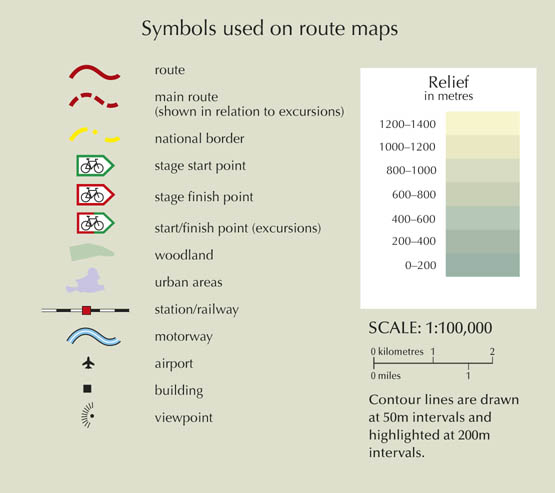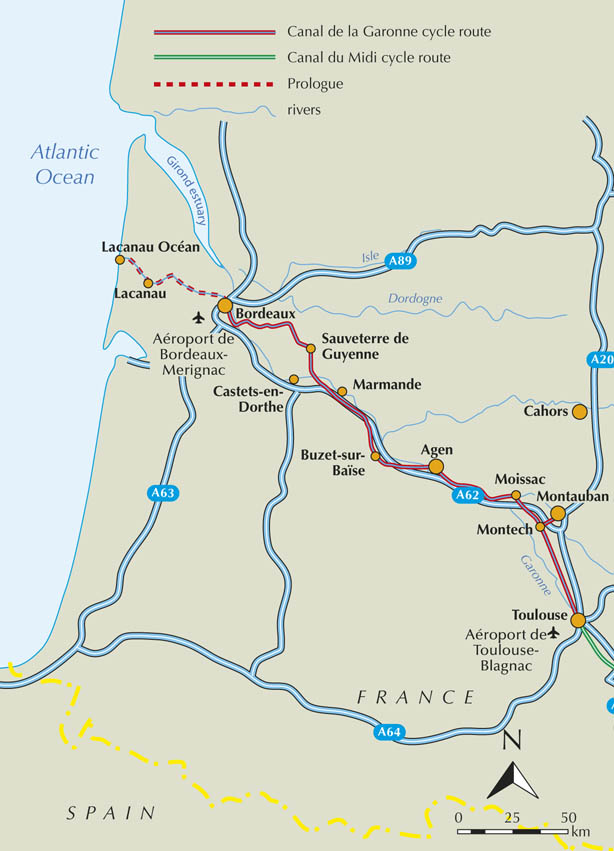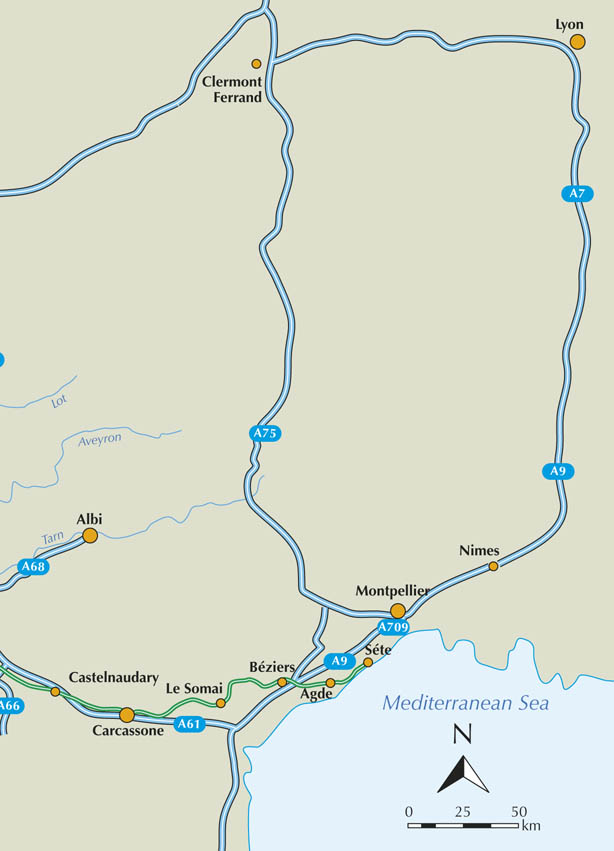About the Author
Declan Lyons has spent many years cycling and touring in the south of France and has written a guide to cycling the Canal du Midi from Toulouse to Ste. He has travelled the routes included in this guide many times over the past two decades and the Canal de la Garonne forms part of his own regular route from the Channel to the Mediterranean. Declan is an advocate of cycle touring taking time on his cycles and relishing the nature, history and daily life all around. He has toured the region between the Atlantic and the Mediterranean extensively by bike and packs much of what he has learnt into his guides.
Other Cicerone guides by the author
Cycling the Canal du Midi from Toulouse to Ste
CYCLING THE CANAL DE LA GARONNE
FROM BORDEAUX TO TOULOUSE
by Declan Lyons
JUNIPER HOUSE, MURLEY MOSS,
OXENHOLME ROAD, KENDAL, CUMBRIA LA9 7RL
www.cicerone.co.uk
Declan Lyons 2019
First edition 2019
ISBN 9781783626908
Printed by KHL Printing, Singapore
A catalogue record for this book is available from the British Library.
All photographs are by the author unless otherwise stated.
 Route mapping by Lovell Johns www.lovelljohns.com
Route mapping by Lovell Johns www.lovelljohns.com
Contains OpenStreetMap.org data OpenStreetMap contributors, CC-BY-SA. NASA relief data courtesy of ESRI
Updates to this guide
While every effort is made by our authors to ensure the accuracy of guidebooks as they go to print, changes can occur during the lifetime of an edition. Any updates that we know of for this guide will be on the Cicerone website (www.cicerone.co.uk/783/updates), so please check before planning your trip. We also advise that you check information about such things as transport, accommodation and shops locally. Even rights of way can be altered over time.
The route maps in this guide are derived from publicly available data, databases and crowd-sourced data. As such they have not been through the detailed checking procedures that would generally be applied to a published map from an official mapping agency, although naturally we have reviewed them closely in the light of local knowledge as part of the preparation of this guide.
We are always grateful for information about any discrepancies between a guidebook and the facts on the ground, sent by email to updates@cicerone.co.uk or by post to Cicerone, Juniper House, Murley Moss, Oxenholme Road, Kendal, LA9 7RL.
Register your book : To sign up to receive free updates, special offers and GPX files where available, register your book at www.cicerone.co.uk.
Acknowledgements
Very many thanks to the staff of Voies Navigables de France (VNF) and the people working in local and regional tourist offices for the valuable help and information that they supplied. Special thanks go to my wife Mary and son Oscar for their support and encouragement while I was both cycling and writing. Mary accompanied me on part of the route and her help then was of great value. Thanks too for the help and guidance from the Cicerone team, especially Lesley and Jonathan Williams, Hannah Stevenson and Andrea Grimshaw, and Stephanie Rebello, editor.
Front cover: Mouling de Loubens (Stage 2)
CONTENTS

The Grosse Cloche over the rue Saint-James in Bordeaux
ROUTE SUMMARY TABLE
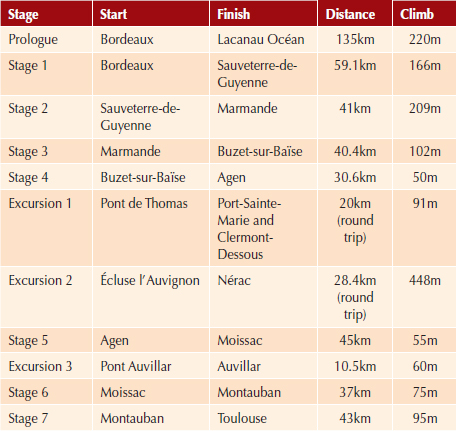

Bordeaux lake is a good place for picnicking (Prologue)
INTRODUCTION
The Bordeaux region is a cycling paradise of long traffic-free stretches of cycle track with gentle climbs through forests, vineyards, farms and medieval villages. The Garonne canal is at the heart of this. Its 193km asphalted towpath from Castets-en-Dorthe to Toulouse is a dedicated cycle path for most of its length. Occasionally, it uses roads but these are minor with little traffic. Both Bordeaux and Toulouse are cycling cities with a network of tracks that allow you to explore them with ease.

The Garonne canal is at the heart of this cycle ride
To reach the canal this guide uses another dedicated cycle path to get from Bordeaux to Sauveterre-de-Guyenne; a gentle climb along a converted railway track to this lovely bastide town. Minor roads are then followed from Sauveterre-de-Guyenne to the canal.
This guide also includes a prologue from Bordeaux to Lacanau on the Atlantic coast. It follows an old railway line that has been converted to a cycle track which passes through the extensive forests of Les Landes. This allows you to recreate in part a route from the Atlantic to Toulouse. In all, over 490km of cycle routes are described ranging from small detours or longer excursions. They offer you the chance to explore and savour the region to the full. The cycle tracks are specified as departmental roads from which motorised vehicles are excluded meaning that they are maintained to a high standard.
The region between Bordeaux and Toulouse is steeped in history and culture. The soil is fertile and produces an abundance of fruit, vegetables and cereals. Its grasslands feed cattle and sheep. People have populated it since pre-historic times. Its rivers allowed early settlers access the interior; they settled on the riverbanks and eventually villages and towns sprang up.
The area has been invaded and fought over frequently. The Romans were among the first to conquer it and the ruins of their occupation are scattered across the Garonne plain. Others followed in quick succession each leaving their mark on the architecture and culture of the region.
The original purpose of the Garonne canal was to complete Pierre-Paul Riquets dream of linking the Atlantic Ocean with the Mediterranean Sea. The idea for some form of canal system had been around since Roman times to obviate the need to circumnavigate the Iberian Peninsula. Riquet instigated the creation of the Canal du Midi from Toulouse to Ste in the 17th century. Prior to this, goods were shipped from Bordeaux to Toulouse by the Garonne river. This was a dangerous stretch of water: there were rapids and shallows particularly in summer and floods and high waters in winter. The journey from the sea inland was obviously against the flow which made it arduous. Heavy rains often made the journey downstream difficult and sometimes treacherous. The Garonne canal overcame these problems and ensured a reliable passage for goods between the two seas.

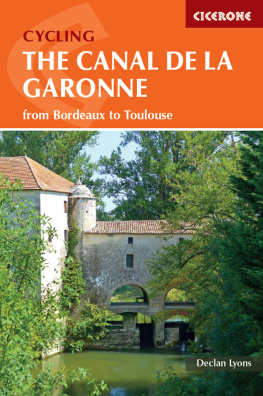
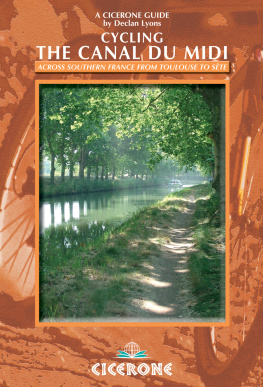




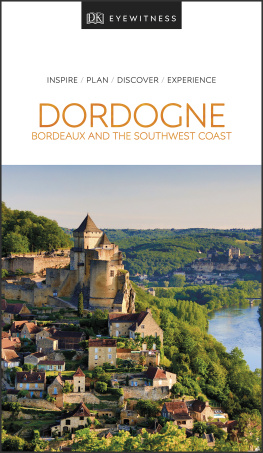

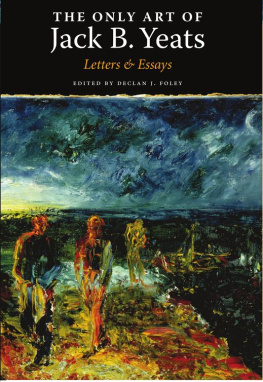
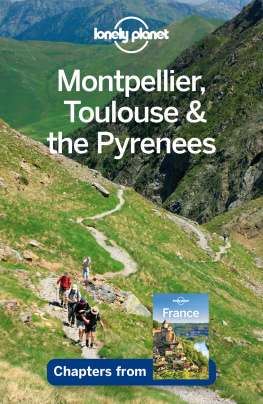




 Route mapping by Lovell Johns www.lovelljohns.com
Route mapping by Lovell Johns www.lovelljohns.com
